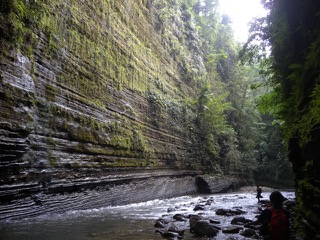Tramping to Lee’s Lake – A very scenic walkabout to some of the most isolated communities in Guadalcanal
The walk starts at Baela where you park your car. To get there, you drive approximately 60 km east towards Aula, then take a logging road south, inland, for another 15 km. The path immediately drops some 400 metres down to the Mongaa River, which will be your companion for the approximately 20 kilometres up to Lee’s Lake. After about four kilometres, you reach the village of Bubunughu, which is the last village you pass through. There is a small canteen – a last chance to pick up any essentials forgotten. From here, the only hills you might have to climb are on detours from the river, which may be necessary if the water levels are very high. You cross the river repeatedly, and some crossings may require you to hoist your backpack onto your head to keep it dry. As always, make sure your essentials are stowed in robust waterproof sacks.
The highlight of the walk comes after about ten kilometres, when you reach the majestic Mabuho Gorge. The guides said it was Noah’s Ark that had somehow gotten stranded here, and indeed, its towering walls resemble the hull of a gigantic ship.
The walk does not require much cardiovascular fitness, as it involves little elevation gain, and if you set aside enough time, there is no need to rush. The trickiest part for me was the very slippery rocks along the banks of the river. I was careful, but I still I lost my footing a dozen times. My clumsiness stood in stark contrast to the agility of the locals we met on the way who, with lightness and ease, skipped barefoot from one algae coated rock to the next. This wasn’t the first time I’ve had my ego deflated by the bushcraft skills of people in the Solomon Islands. One option is to make arrangements for someone to carry the backpack, which might help the unsteady among us to regain some dignity.
Once you reach the shore of the lake, your guide will call across to the other side for one of the villagers to come pick you up in a canoe. The crossing takes about 20 minutes, and on the other side awaits your new home. You can either stay with a family, as many families have spare huts, or you can pitch a tent. There are no mosquitoes, but there are centipedes. I stayed with the Misek family who were exceptionally hospitable, especially bearing in mind that they didn’t know I was coming, and hadn’t had a ‘white man’ visit their village in many years.
As for food, you again have the option of bringing your own, or eating from the local menu, which at Lee’s Lake is made up of tilapia, crayfish, eel, other fish with names I cannot recall, pumpkin, sweet potato, taro, yams, and lots of greens – a pretty healthy diet. Two-dollar instant noodles are far away. Either way, bring some salt, sugar and cooking oil as gifts, as these are commodities that people here cannot get hold of easily.
It is worth staying at the lake for a full day. I did. The list of activities is long; visiting nearby waterfalls, fishing, catching crayfish with a spear – which can then be immediately grilled over a fire. It is also nice to go for a long swim across the calm surface of the cool lake. In the evening, over the fire (it gets a bit chilly at night), you are entertained and educated with kustom stories about giants, dogs as big as cows, and sacred tabu locations in the vicinity with powers known to have made people vanish for failure to respect prescribed rituals.
So, how did Lee’s Lake get its name? Well, there is actually a local name too, but I’ll leave it to you to investigate who Mr. Lee was, and how this lake came to adopt his name.
Should you be interested in a walkabout to Lee’s Lake, send a text message to Michael on 8450259 and he will make all the arrangements. If your pack is heavy, he can arrange for porters, and indeed he can sort out anything else you may need. You can try calling too, but he is often out of cell phone coverage. If you send a text he will get it as soon as he gets reception, and will then call you back.
Marcus Baltzer

